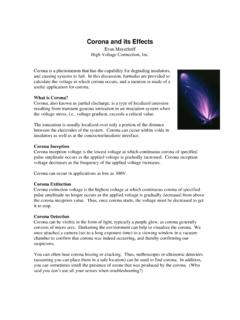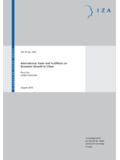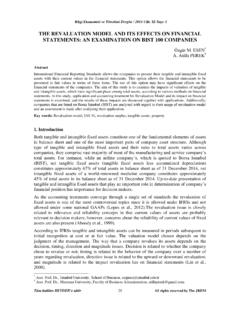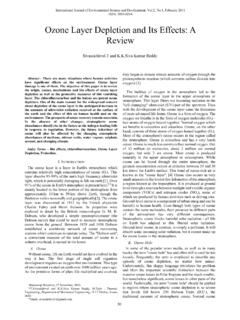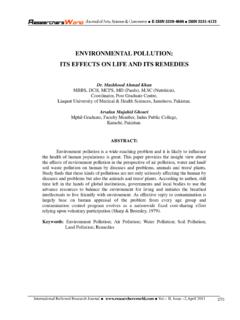Transcription of Damaging Effects of Roundup (and its active …
1 Damaging Effects of Roundup ( and its active ingredient glyphosate)Glyphosate was patented by Monsanto as the active ingredient in their Roundup brand. Monsanto also introduced genetically modified (GM) Roundup Ready (RR) soy, corn, cotton, canola, sugar beets, and alfalfa all designed to withstand Roundup s normally deadly by itself is only mildly toxic to plants and doesn t usually destroy weeds directly. As a broad-spectrum chelator,1 it binds with nutrients, depriving plants of the minerals needed to help them defend against disease. At the same time, glyphosate can stimulate disease-creating organisms in the soil such as fusarium, which then wipe out the weakened plants. Glyphosate also remains in tact in the soil for months or years, and can even be found in the manure of chickens fed RR also changes soil microbiology in ways that can reduce plant nourishment and vitality, particularly nitrogen fixation; interferes with photosynthesis; reduces water use efficiency; lowers lignin content; damages and shortens root systems; causes plants to release important sugars; and changes soil pH all of which can negatively affect crop also accumulates in the food portion of Roundup Ready plants, for which allowable residue herbicide thresholds have been increased by up to 200-fold.
2 Glyphosate exposure has been linked to sterility, hormone disruption, abnormal and lower sperm counts, miscarriages, damaged human embryonic and placental cells, placental cell death, birth defects, and cancer. It is also toxic and lethal to crops increase Roundup useWhen Monsanto introduced Roundup Ready crops 1996, they boldly claimed that herbicide use would decrease as a result. It did slightly for three years. But over the next 10 years it grew considerably. Total herbicide use in the US jumped by 383 million pounds, or about 10%, in the 13 years after GMOs came on the scene. The primary reason for the increase is the accelerating spread of herbicide tolerant weeds. These were reported on 30,000 sites, affecting up to million acres, up from 3,251 sites on million acres in 2007.
3 The cost for farmers is estimated almost $1 billion each year, or $10-20 per are applying significantly more Roundup . Nearly half of the huge 13-year increase in herbicide use took place in just the last 2 years. Although the biotech industry points to a study claiming that GM crops reduce herbicide use, a careful analysis shows how unsupported assumptions and inappropriate methods were used to arrive at this for Responsible Technology - PO Box 469 - Fairfield, IA - - (641)-209-1765 Glyphosate: Promotes more than 40 plant diseases, some of which also can produce tox-ins that are dangerous to animals and humans. Removes essential nutrients from crops, which can result in deficiencies in live-stock and possibly humans.
4 Can adversely affect future crops planted on the same field or treated with glyphosate-ridden chelates iron, zinc, copper, manganese, magnesium, calcium, boron, nickel and others, essentially removing them from the pool of nutrients available for plants, animals, and humans. Glyphosate-induced mineral deficiencies can easily go unidentified and untreated. Laboratory tests can sometimes detect adequate minerals, but miss the fact that glyphosate has rendered them 2 References:1 A decade before it was patented as an herbicide, glyphosate was patented as a chelator of numerous minerals. 2 List of References on the Plant Effects of Glyphosate ( Roundup ) Bellaloui, N, et al, Effects of Glyphosate Application on Seed Iron and Root Ferric (III) Reductase in Soybean Cultivars, J.
5 Agric. Food Chem. 2009, 57, 9569 9574 Datnoff, , Elmer, , Huber, , 2007. Mineral Nutrition and Plant Disease. APS Press, , MN. Dodds, , Hickman, , Huber, , 2002a. Micronutrient uptake by isogenic glyphosate tolerant and normal corn. Proc. Sci. Soc. Am. 42, 2. Dodds, , Huber, , Hickman, , 2002b. Micronutrient levels in normal and glyphosate-resistant soybeans. Proc. NC- Weed Sci. Soc. Am. 57, 107. Dodds, , Huber, , Hickman, , Shaw, , 2002c. Hybrid and glyphosate application Effects on nutrient uptake in corn. Proc. Weed Sci. Soc. Am. 43, 4. Eker, S., Ozturk, L., Yazici, A., Erenoglu, B., Romheld, V., Cakmak, I., 2006. Foliarapplied glyphosate substantially reduced uptake and transport of iron and manganese in sunflower (Helianthus annuus L.)
6 Plants. J. Agric. Food Chem. 54, 10019 10025. Englehard, (Ed.), 1989. Management of Diseases with Macro and Microelements. American Phytopathological Society, St. Paul, MN. Evans, , Solberg, E., Huber, , 2007. Copper and plant disease. In: Datnoff, , Elmer, , Huber, (Eds.), Mineral Nutrition and Plant Disease. APS Press, St. Paul, MN, pp. 177 188 (Chapter 12). Gordon, B., 2006. Manganese nutrition of glyphosate- resistant and conventional soybeans. Better Crops 91, 12 13. Hickman, , Dodds, , Huber, , 2002. Micronutrient interactions reduce glyphosate efficacy on tall fescue. Proc. Weed Sci. Soc. Am. 42, 18. Huber, , Graham, , 1999. The role of nutrition in crop resistance and tolerance to diseases.
7 In: Rengel, Z. (Ed.), Mineral Nutrition of Crops: Fundamental Mechanisms and Implications. Food Products Press, London, pp. 169 204. Huber, , Leuck, , Smith, , Christmas, , 2004. Induced manganese deficiency in GM soybeans. In: Northcentral Fert. Extension Conf., Des Moines, IA, November 2004. Huber, , Cheng, ,Winsor, , 2005. Association of severe Corynespora root rot of soybean with glyphosate-killed giant ragweed. Phytopathology 95, S45. Johal, , Rahe, , 1984. effect of soilborne plant- pathogenic fungi on the herbicidal action of glyphosate on bean seedlings. Phytopathology 74, 950 955. Johal, Huber, Glyphosate Effects on diseases of plants, Europ. J. Agronomy 31 (2009) 144 152 Kremer, , Donald, , Keaster, ,Minor, , 2000.
8 Herbicide impact on Fusarium spp. and soybean cyst nematode in glyphosate- tolerant soybean. Agron. Abstr., p257. Kremer, ,Means, , Kim, , 2005. Glyphosate affects soybean root exudation and rhizosphere microorganisms. Int. J. Environ. Anal. Chem. 85, 1165 1174. Kremer, , Means, , 2009. Glyphosate and glyphosate-resistant crop interactions with rhizosphere microorganisms. Eur. J. Agron. 31, 153 161. Larson, ,Hill, , Fenwick,A.,Kniss, ,Hanson, ,Miller, , 2006. Influence of glyphosate on Rhizoctonia and Fusarium root rot in sugar beet. Pest Manag. Sci. 62, 182 192. Levesque, , Rahe, , et al., 1987. Effects of glyphosate on Fusarium spp.: its influence on root colonization of weeds, propagule density in the soil, and on crop emergence.
9 Can. J. Microbiol. 33, 354 360. Levesque, , Rahe, , 1992. Herbicide interactions with fungal root pathogens, with special reference to glyphosate. Annu. Rev. Phytopathol. 30, 579 Johal, Huber / Europ. J. Agronomy 31 (2009) 144 152 Levesque, , Rahe, , Eaves, , 1993. Fungal colonization of glyphosate treated seedlings using a new root plating technique. Mycol. Res. 97, 299 306. Liu, L., Punja, , Rahe, , 1997. Altered root exudation and suppression of induced lignification as mechanisms of predisposition by glyphosate of beanroots (Phaseolus vulgaris L.) to colonization by Pythium spp. Physiol. Mol. Plant Pathol. 51,111 persists in the environmentMonsanto used to boast that Roundup is biodegradable, claiming that it breaks down quickly in the soil.
10 But courts in the US and Europe disagreed and found them guilty of false advertising. Monsanto s own test data revealed that only 2% of the product broke down after 28 glyphosate concentration in the soil builds up season after season with each subsequent application. It can also accumulate for 6-8 years inside perennial plants like alfalfa. Glyphosate residues in the soil that become bound can be reactivated by the application of phosphate fertilizers or other methods. US potato growers, for example, have experienced severe losses from glyphosate that has been for Responsible Technology - PO Box 469 - Fairfield, IA - - (641)-209-1765 Damaging Effects of Roundup ( and its active ingredient glyphosate)Wheat affected after 10 years of glyphosate field applicationsPage 3 McCay-Buis, , 1998.


